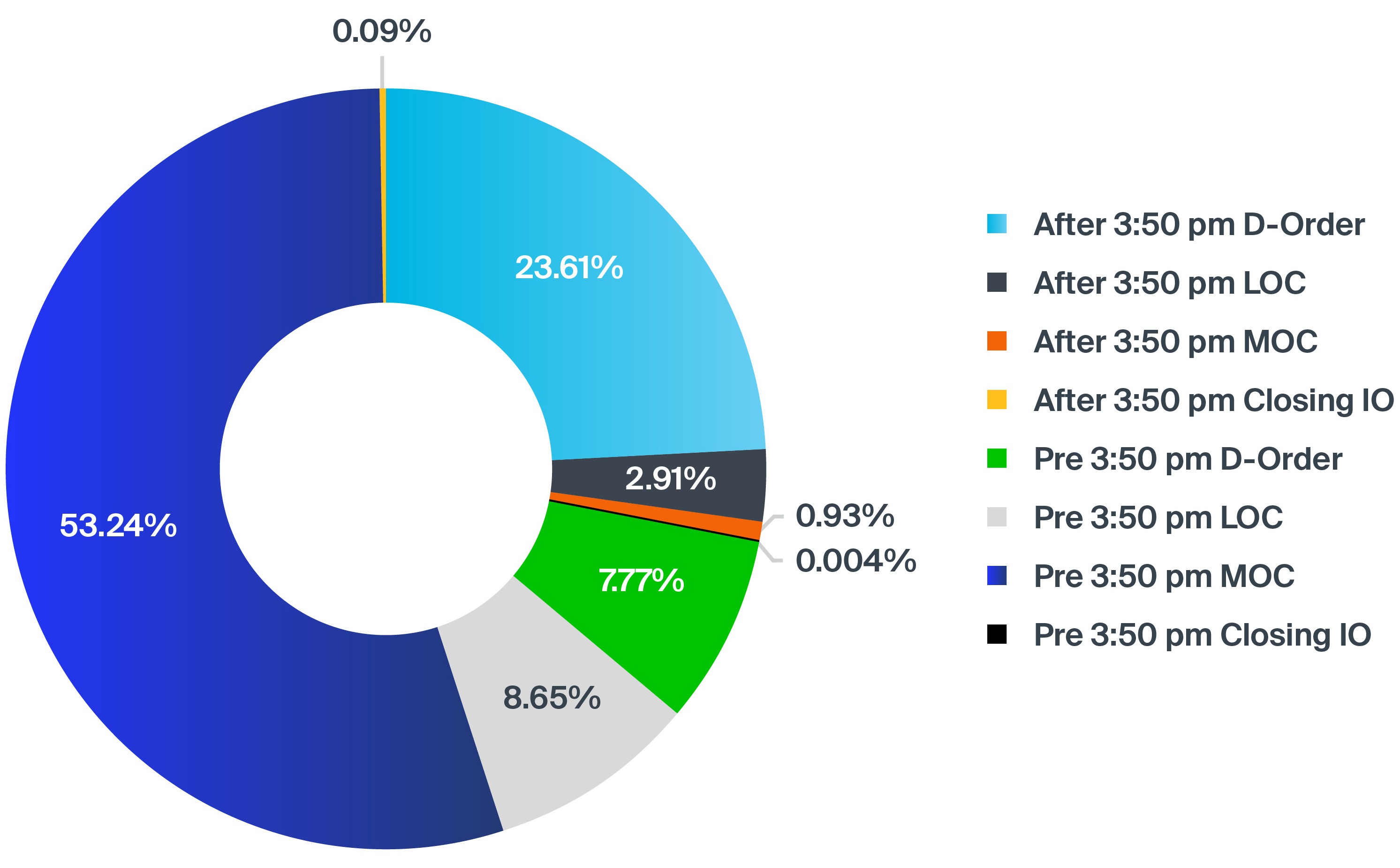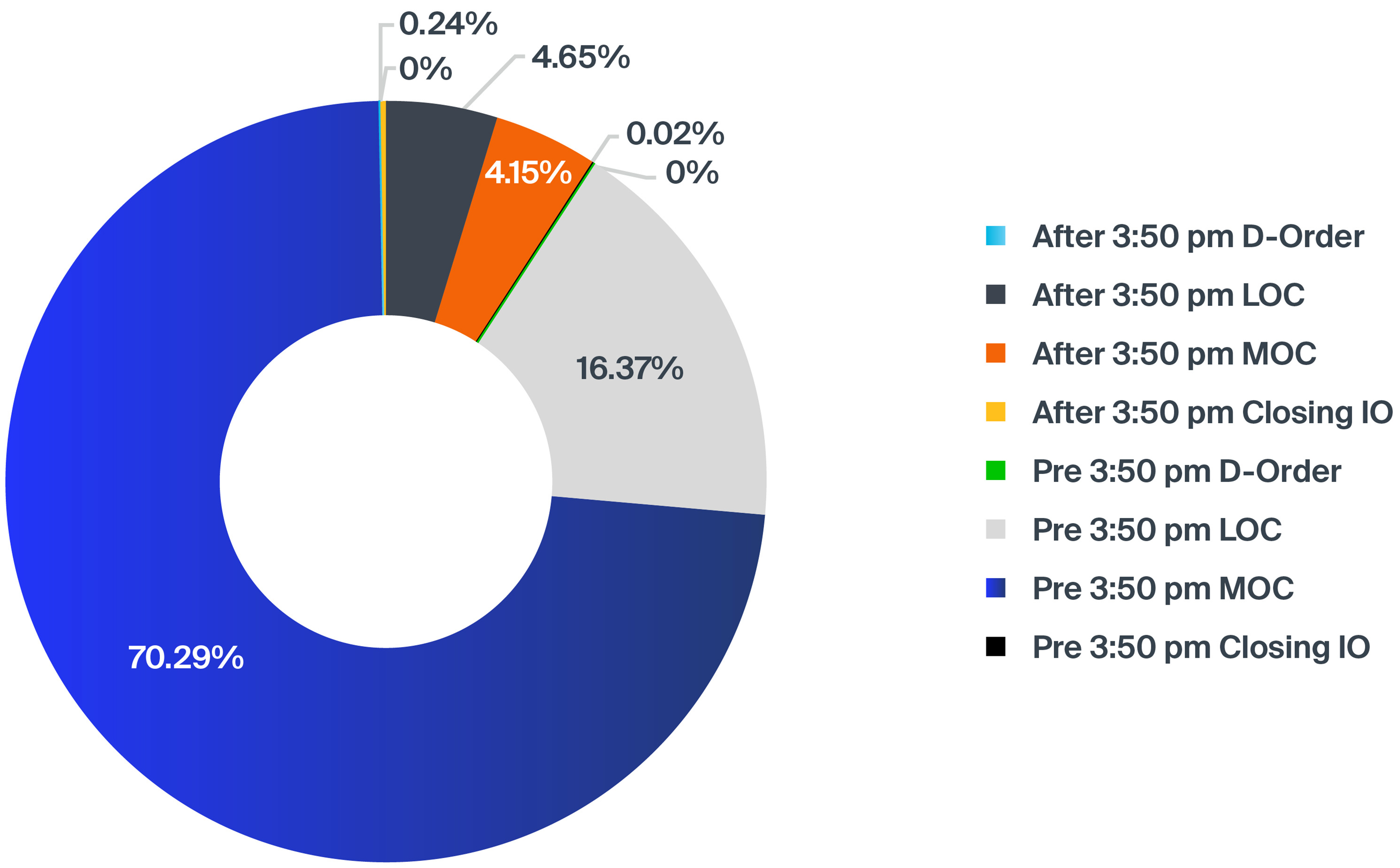April 21, 2020
Michael Blaugrund, COO, NYSE Group
The New York Stock Exchange has been temporarily all-electronic since March 23. As we’ve noted before, DMMs can electronically open and close securities during this time, and auctions that cannot be facilitated electronically by DMM algorithms are currently facilitated by the NYSE’s exchange-facilitated-auction (EFA).
While the Trading Floor is temporarily closed, D Orders, which comprise up to 40% of the NYSE Closing Auction, are not available. As a result, market participants have had to adjust behavior when trading in the Closing Auction. Below, we review the alternative functionality and share data on recent usage.
Order Types and Functionality
The following order types are currently available for the Closing Auction:
- Limit on Close (LOC)
- Market on Close (MOC)
- Closing Imbalance Offset orders (Closing IO)
MOC and LOC orders can be entered and modified up to 3:50 p.m. ET. Closing IO orders can be entered up to 4 p.m. ET on either side of a closing imbalance, but cannot be cancelled after 3:50 p.m. ET.
Additionally, market participants may submit offsetting MOCs and LOCs up to 4 p.m. in symbols with a Regulatory Closing Imbalance. A Regulatory Closing Imbalance is published by the Exchange at 3:50 p.m. ET in every symbol with an imbalance of at least 500 round lots (generally 50,000 shares). When a Regulatory Closing Imbalance is published, NYSE accepts MOC and LOC orders on the opposite side of that imbalance between 3:50 p.m. and 4 p.m. and rejects any other incoming MOC and LOC orders.
Closing Order Types Usage
January 1 - March 20, 2020
Executed Volume As % Of Closing Auction By Time Of Order Entered

March 23 - April 6, 2020
Executed Volume As % Of Closing Auction By Time Of Order Entered

Offsetting a Regulatory Closing Imbalance
- Since March 23, NYSE has had an average of 489 Regulatory Closing Imbalances per day, and auctions with a Regulatory Closing Imbalance account for about 70% of total shares executed in the NYSE Closing Auction.
- On March 31, 2020 quarter-end close, 834 securities had a Regulatory Closing Imbalance.
- As stated above, 95% of the NYSE auctions are conducted by a DMM, and in those auctions, all MOCs and better-priced LOCs are fully executed.
- In addition to MOCs and LOCs at better prices, firms can enter Closing IO orders and at-price LOCs to further offset the imbalance. We observed an increase of MOC, at-price LOC and at- or better-priced Closing IO from March 23 to April 6, 2020:
Orders Submitted After 3:50 p.m. in All Symbols
| % of All MOC | % of All At Price LOC | % of All At Or Better Price Closing IO | |
| January 1 - March 20 | 4.8% | 31.4% | 99.8% |
| March 23 - April 6 | 15.0% | 47.8% | 99.0% |
Fill Rate Performance
- In the NYSE Closing Auction, execution priority at the closing price can be summarized as:
- Better-priced interest (MOCs and better-priced LOCs and limit orders) guaranteed
- Displayed limit orders at the closing price allocated on parity
- Non-displayed limit orders at the closing price (i.e., reserve interest) allocated on parity
- LOC orders at the closing price allocated on time
- Closing IO orders on the opposite side of any unpaired quantity allocated on time
- The Closing IO fill rate improved from 34.1% during January 1 - March 20, 2020 to 41.3% for March 23 - April 6, 2020.
- Nearly half of all Closing IO orders are entered between 3:50 p.m. and 3:59 p.m., while previously nearly all were entered in the last minute.
- The addition of Closing IO orders entered before 3:59 p.m. has reduced the fill rate for Closing IO orders entered in the last minute.
- Prior to the temporary Floor closure, 27.9% of at-price LOC orders were submitted in the last minute of the day; this share has increased as D orders are not available
- There are a greater number of at-priced LOC orders entered after the cutoff but before the last minute of the day; these orders have a slightly higher fill rate than orders submitted in the very last minute.
Closing IO At Price by Time of Order Entered
| Fill Rate At Or Better Prices | % of At Price Orders Submitted | |||
| Jan 1 - March 20 | March 23 and After | Jan 1 - March 20 | March 23 and After | |
| 1) 6:30:00 - 9:30:00 | 0.0% | 0.1% | 0.0% | 0.2% |
| 2) 9:30:00 - 3:49:59 | 1.0% | 2.6% | 0.1% | 0.8% |
| 3) 3:50:00 - 3:58:59 | 1.2% | 22.5% | 0.1% | 47.7% |
| 4) 3:59:00 - 4:00:00 | 31.9% | 16.1% | 99.8% | 51.4% |
| 34.1% | 41.3% | 100.0% | 100.0% | |
LOC At Price by Time of Order Entered
| Fill Rate At Or Better Prices | % of At Price Orders Submitted | |||
| Jan 1 - March 20 | March 23 and After | Jan 1 - March 20 | March 23 and After | |
| 1) 6:30:00 - 9:30:00 | 0.0% | 0.1% | 0.1% | 0.1% |
| 2) 9:30:00 - 3:49:59 | 29.8% | 22.0% | 68.5% | 52.1% |
| 3) 3:50:00 - 3:58:59 | 1.2% | 9.6% | 3.5% | 15.5% |
| 4) 3:59:00 - 4:00:00 | 11.8% | 8.6% | 27.9% | 32.3% |
| 42.8% | 40.2% | 100.0% | 100.0% | |
Next Steps
While the Trading Floor is temporarily unavailable, market participants have multiple alternatives to access the NYSE Closing Auction. We observe that D Orders have been replaced largely by MOC and LOC orders entered before 3:50 p.m. However, we anticipate continued growth in usage of Closing IO orders, which have seen an improvement in performance following the March 23 temporary closure and offer additional opportunities to offset Closing Auction imbalances.
Please contact the RM Team for assistance with accessing these order types.
NYSE Research Insights
Find all of NYSE Research's articles on market quality, market structure, auctions, and options.